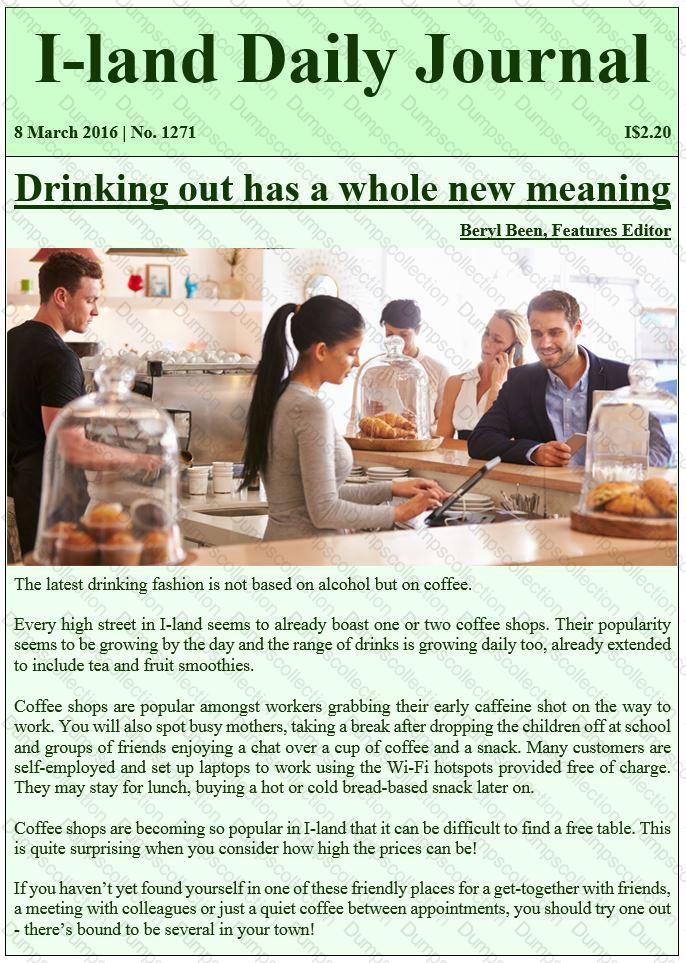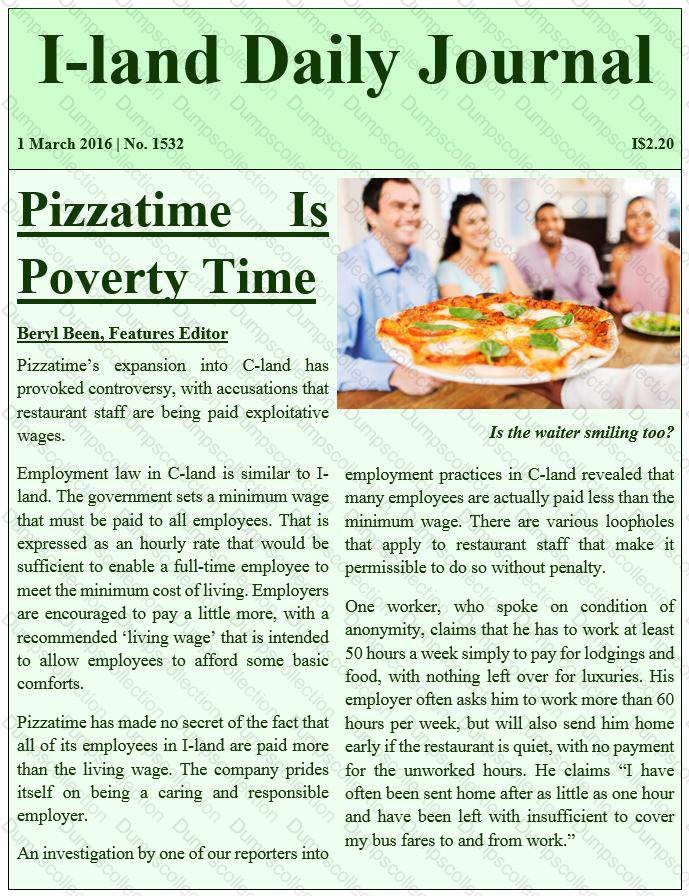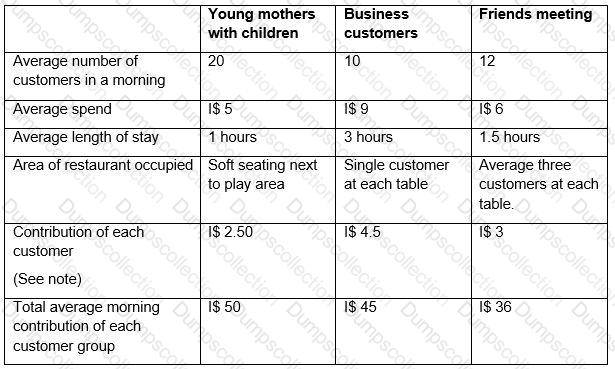CIMA CIMA Gateway Exam G1 Exam Dumps: Updated Questions & Answers (December 2025)
One month has passed and more detailed decisions are now needed on pricing and the change management issues associated with the introduction of the new menu and hi-tech ordering system.
You have just received the following email from the Finance Director:
From: Matt Spot, Finance Director
To: Financial Manager
Subject: pricing and change management
Hello
Things are moving fast. We have just had feedback from a select group of customers. They were asked to test out the new menu and hi-tech ordering devices. The feedback was very positive, especially about the ordering devices which, they said, add an element of fun to the restaurant experience as well as speeding up the food ordering process. Families with young children were particularly enthusiastic about them and found that even young children enjoyed ordering their own food. They all agreed to keep the project secret, so we're hoping they will!
I have meetings arranged with Bilal Mukherjee, Marketing Director, and Helga Schmidt, Human Resources Director, to draw up plans for pricing and for change management and I need some information from you in preparation for them.
In terms of pricing, I am expecting that Bilal will suggest that we price the new menu quite high to begin with, following the example of a new burger chain which has been successful at charging higher prices for a top quality product and has attracted a lot of young working adults as customers. However, I am not convinced that this will work for Pizzatime.
Bilal has been given permission to organise a major promotional campaign to sell the health benefits of the new menu and show children and young adults having fun using the new ordering devices.
Clearly, there are going be some major changes in the roles and positions of staff within the restaurant team. Now that orders can be placed by customers from their tables the roles of restaurant staff are going to change significantly. Helga is concerned that there are likely to be some job losses and she may be right on that. We need to have a plan in place to make sure we are prepared for every eventuality so that we can manage the changes properly.
I need you to prepare some ideas on the following:
Whether I should support Bilal's suggestion to charge high prices initially. Do you think that this is likely to be a successful strategy for Pizzatime?
What types of concerns employees might have about the new ordering system and how we can best prepare staff for the change and help smooth the process to make this new venture an immediate success.
Matt
You have received the following email:
From: Matt Spot, Finance Director
To: Financial Manager
Subject: new menu
Hello
As a first stage in its development plans the Board have decided that Pizzatime must develop a new menu that uses top quality ingredients. The menu will include many more healthy and lower calorie options. This project has been given a high priority and we need to start researching and planning the new menu straight away.
I am considering organising some big data research to give us greater insight into our customers' requirements. For example, it would help us find out how important fresh ingredients, the use of local produce and fewer processed meat products are to our customers. I realise that many customers are trying to lose weight and it would also be interesting to know what type of weight loss programmes they are using and what foods are permitted under each one.
I need your help on this one. Please email me your thoughts on the following:
Firstly, what sources of competitor and customer analysis should we use when drawing up a new menu? Please include the possibility of using big data and look at other useful sources of information.
Secondly, what are the downside risks to Pizzatime of introducing a new menu and are they worth taking?
Matt

You have received the following email:
From: Matt Spot, Finance Director
To: Financial Manager
Subject: all-day opening proposal – CONFIDENTIAL
Hello
I have just had an interesting meeting with Bilal Mukherjee, our Marketing Director. Bilal has been thinking of ways to put our restaurants to work during the day. At present, most of our restaurants are closed all morning and the afternoon between the end of lunch and the start of the evening rush. We are all well aware of the rapid growth of coffee shops in I-land over last 12 months; please see the attached newspaper article.
Bilal believes that we should open our restaurants to sell snacks, coffees, and light meals from early morning until early evening, with the exception of lunchtime when we would offer restaurant meals, so we wouldn't be interfering with our core business.
The main issue is the surprising expense required to start this venture. We would have to invest heavily in advertising and other promotions and would also need to seek separate permission from local government. Finally, we would have to buy a sophisticated coffee machine and equipment to heat and serve hot snacks for each restaurant. Our restaurants are equipped to cook pizza, not hot breakfast. Needless to say, we can't just buy the equipment and plug it in.
We will have to adapt our premises to make space for the new equipment. Bilal is suggesting that we introduce more family-friendly seating areas, removing a number of tables and replacing them with sofas and a toy kitchen area for young children to enjoy.
Bilal is concerned that the heavy outlays on advice for the local government applications, along with the significant investment in property, plant and equipment, will mean that this venture will have a very low accounting rate of return (ARR) for the first year. I rarely look beyond the net present value of a project, but he may have a point.
Please reply as soon as possible on the following:
Firstly, is this proposed all-day opening venture consistent with our strategic objectives?
Secondly, draft an explanation that I can take to the Board on possible reasons why the project's forecast ARR in the first year is so poor. Are forecast ARR results likely to give a good indication of the overall performance of the venture?
Matt

A further three months have passed. Pizzatime now has 15 franchised restaurants in C-land, mainly in large towns and cities. You have received the following email:
From: Monica Lall, Chief Executive
To: Financial Manager
Subject: press report
Hi,
Have you seen the latest news story? I have attached a copy to this email just in case.
We need your advice. As you know, the franchise agreements that we have signed with restaurants in I-land and P-land specify that there will be a standard employment contract for all employees. Franchise holders are required to offer their restaurant staff the same terms and conditions as we have in the restaurants that we own ourselves. We have always been regarded as responsible employers and we pay more than the minimum 'living wage' that has been calculated by the governments of both I-land and P-land.
Potential franchisees in C-land refused to grant us the right to set a minimum rate of pay or to standardise terms and conditions. We were forced to permit them to decide for themselves in order to have them sign up. Legally speaking, none of the restaurant staff in C-land work for us, they are all employees of the franchise owners. Perhaps we should have foreseen this, but we did not appreciate that the culture in C-land was quite so unsympathetic.
Regardless of what has gone wrong in the past, we are clearly going to have to make changes. We have already written to all franchisees in C-land to inform them that we will be monitoring their employment practices closely. Unfortunately, we have not yet decided how we are going to do that.
I need you to brief me on two issues.
Firstly, how big an impact can national cultures have on business practices? Was it unethical of us to have agreed to permit franchisees in C-land to set their own employment terms?
Secondly, what reporting systems might we put in place to ensure that C-land's franchisees treat their staff in a manner that would be deemed acceptable in terms of our corporate values? Explain how we could make this monitoring effective.
Regards
Monica Lall
Chief Executive
Pizzatime
Customer value analysis
Note
When calculating the contribution of each customer, staff and other running costs for the morning shift are apportioned according to the amount spent. Fixed overheads, such as regional and central office costs and decor and kitchen equipment such as the cost of the coffee machine, are ignored.

The Marketing Director stops you in the corridor and says the following:
"I need your help. A firm of consultants has pitched a proposal to the Board to conduct a value chain analysis for Pizzatime. The Chief Executive is interested, but he would like us to discuss the proposal further at the next Board meeting before we decide whether to brief the consultants. He also feels that there are other areas we should explore, particularly the strategic focus of the company. I have left a copy of the consultants' presentation on your desk.
The Chief Executive has asked me to prepare a board paper on two issues.
Firstly, what would a value chain analysis involve in the case of Pizzatime and how might we involve our staff more in creating value?
Secondly, the Chief Executive is unsure whether we should focus our value chain analysis in a low-cost strategy or a differentiation strategy.
Please draft the board paper for me. I will review it and present it at the next board meeting."
The consultants' presentation can be found by clicking the Reference Material button above.
The pilot all-day opening venture at ten of Pizzatime's restaurants in the I-Town region has now been operational for six weeks. You have just received the email below from Matt Spot.
From: Matt Spot, Finance Director
To: Financial Manager
Subject: review of performance of all-day opening
Hello
We are now in a position to review the performance of all-day opening. The main challenge that we have faced is the different requirements of each of the following primary sets of customers:
• Young mothers with children who appreciate the soft seating and play area and the chance to meet with other mothers and their young children.
• Friends meeting.
• Business customers with laptops who prefer occupying their own table.
Business customers prefer a quiet environment and numbers are falling as they try Pizzatime once and then go elsewhere because of the noisy children. I wonder if we should, reluctantly, remove the play area to discourage young mothers and children from using the restaurants except at lunchtime. I am attaching a customer value analysis by group to help with the decision.
In terms of performance, it is disappointing that target times from order to delivery have not been met and staff are not chatting to customers as well as coffee shop staff do. These service levels need to be improved without delay. Please report back to me on:
Whether the customer value analysis in the attachment might help with the decision on whether to remove the play area.
What action we should take to influence and persuade staff to improve service levels.
Matt

The Marketing Director stops you in the corridor and says the following:
"I need your help. A firm of consultants has pitched a proposal to the Board to conduct a value chain analysis for Pizzatime. The Chief Executive is interested, but he would like us to discuss the proposal further at the next Board meeting before we decide whether to brief the consultants. He also feels that there are other areas we should explore, particularly the strategic focus of the company. I have left a copy of the consultants' presentation on your desk.
The Chief Executive has asked me to prepare a board paper on two issues.
Firstly, what would a value chain analysis involve in the case of Pizzatime and how might we involve our staff more in creating value?
Secondly, the Chief Executive is unsure whether we should focus our value chain analysis in a low-cost strategy or a differentiation strategy.
Please draft the board paper for me. I will review it and present it at the next board meeting."

